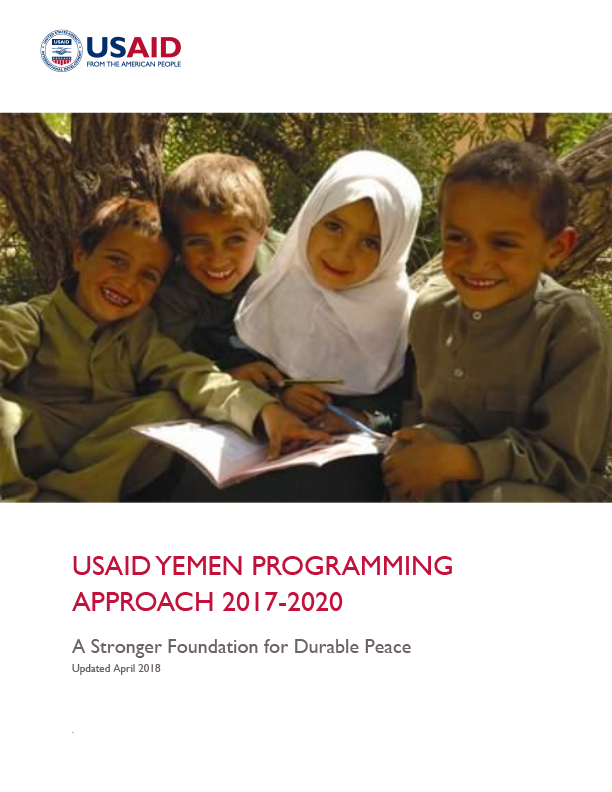Speeches Shim
A Stronger Foundation for Durable Peace
Updated April 2018
Yemen's current conflict is complex and multifaceted. Fighting continues between those aligned with the Houthis and forces allied with the internationally recognized Republic of Yemen Government (ROYG), backed by a coalition led by Saudi Arabia and supported by the United States. Beyond the larger regional conflict, there are a wide range of local conflicts and grievances - including some secessionist elements - that were not resolved during the 2012 transition. Political instability, a security vacuum, and fractured governance have allowed Al Qaeda in the Arabian Peninsula (AQAP), the Islamic State-Yemen (ISY), and other extremist groups to expand their areas of influence. During the conflict, Yemen’s social fabric has frayed, polarizing communities and deepening societal divisions in ways that will create significant obstacles for peace and reconciliation processes and challenge Yemen’s stability for years to come. Some parties to the conflict – including regional actors – seek to amplify these divisions. Many conflict actors are also benefiting from a wartime economy and profiteering in ways that create further obstacles to peace.
Meanwhile, Yemenis are facing a dire humanitarian situation exacerbated by a looming economic collapse. The war has resulted in massive destruction of infrastructure, erosion of institutions, substantial displacement of families, and acute food insecurity, with some areas on the brink of famine. Basic human services are collapsing: two million children –more than a quarter of Yemen’s school-aged children - have been deprived access to schooling, only 50 percent of health facilities are functional, and 16 million Yemenis lack access to clean drinking water and sanitation. The unprecedented cholera outbreak that began in April 2017 is evidence of this erosion of health and water, sanitation, and hygiene (WASH) systems. Contraction of employment opportunities in both formal and informal sectors has significantly reduced household incomes, and Yemenis are increasingly exhausting their coping mechanisms. These conditions are unlikely to change absent a durable political resolution to the conflict.
PURPOSE AND STRUCTURE OF THE YEMEN PROGRAMMING APPROACH
Humanitarian assistance is critical in Yemen, but on its own will not prevent the collapse of key social and economic institutions, stem the tide of conflict, or build Yemen’s resilience to future shocks. For this reason, USAID/Yemen is significantly expanding its development assistance to help put the country on a path to recovery and prevent continued dependence on humanitarian aid.
USAID/Yemen believes that effectively designing and implementing programs in such a complex, protracted conflict environment requires an integrated strategic approach to guide programming that builds on the Agency’s substantial humanitarian investments. However, that approach must also be highly adaptive and able to respond to rapidly changing conditions and needs. To achieve this balance, USAID/Yemen developed a plan for monitoring key aspects of the Yemen context in a way that will allow the team to anticipate shifts along various potential scenarios - including continued, worsened, or shifting conflict, a sustained cessation of hostilities, or a peace agreement.
The Yemen Programming Approach (YPA) identifies goals, objectives, and outcomes that are relevant across all potential scenarios Yemen may face. These outcomes are consistent enough with the current status quo to be meaningful to activities in the near term, while ambitious enough to provide a vision for programming. The activities nested underneath these outcomes have been designed to both specifically target the unique needs and conditions of a given scenario, and with the flexibility needed to adapt as conditions on the ground evolve and the country shifts into different scenarios.
Because Yemen is a non-permissive environment - which precludes prescriptive planning - the YPA is intentionally not a “project” or “strategy.” Instead, the YPA is intended to serve as a foundation for adaptive planning. Ongoing learning and adaptation are critical to this approach and have also been integrated into all activities designed under the YPA. The team will conduct a stocktaking exercise after the three years, after which the YPA may be revalidated and extended for up to an additional two year period.


Comment
Make a general inquiry or suggest an improvement.